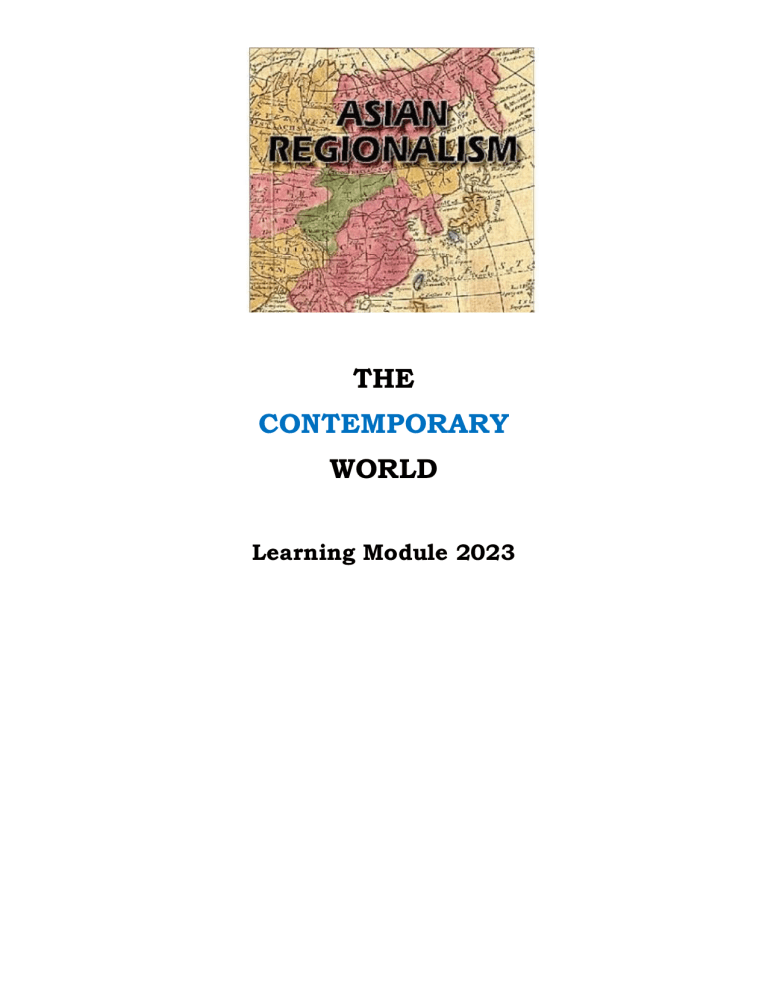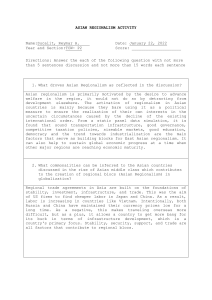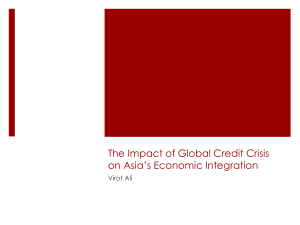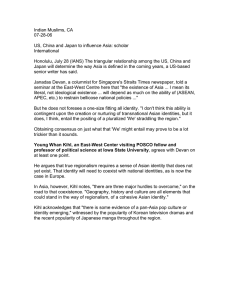Uploaded by
czarrienhelsanchezb
Asian Regionalism: A Contemporary World Learning Module
advertisement

THE CONTEMPORARY WORLD Learning Module 2023 THE CONTEMPORARY WORLD Learning Module As a result of the request of students at the University of Caloocan City, this learning module has been conducted by students at the University of Caloocan City in response to the requests for adaptable learning materials and evaluations that are based on the performance of the students within the class. The module incorporates solo and group assignments to expose learners to the current world, including the emergence of economic, political, social, and cultural systems associated with globalization. The goal of this course is to help students improve their critical and analytical thinking skills as global citizens by assisting them in considering their responsibilities as global citizens. THE CONTEMPORARY WORLD About the Course Throughout this subject, students are introduced to the modern world by taking a closer look at the complex phenomenon of globalization that is taking place. It employs a wide range of social science disciplines to investigate the economic, social, political, technological, and other changes that have expanded awareness of the interconnectedness of people and places across the world. This course consists of necessary subjects on population education within the context of population and demography. THE CONTEMPORARY WORLD About the Author This learning module was put together by students from the University of Caloocan City's Bachelor of Science in Accounting Information System section 1A. KRISHA LEI OLANDA JEFFERSON J. PIASTRO MARIA KAYLE G. OLIVO KENNETH JAY V. QUARTEROS JAY ANN U. PANTALEON NOLI JOEF M. REYES AILEEN JOY T. PAUGIA JERLYN CASSANDRA M. SALAZAR CZARRIENHEL L. SANCHEZ JOHN KENNETH A. SATURNINO JAN GABRIELLE A. VELASCO MICO C. ZINAMPAN The Contemporary World TABLE OF CONTENTS What is Regionalism? What is Globalization? What is the Difference between Regionalization and Globalization? What is Asian Regionalism? Why Asian Regionalism Importance of Asian Regionalism What are the three propositions of Asian Regionalism? What are the positive and negative effects of Asian Regionalism? What are the effects of Asian Regionalism to the Philippines? Asian Regionalism LESSON: ASIAN REGIONALISM Asian regionalism has been a key factor in determining the political, social, and economic environments on the continent. Asian countries, with their varied cultures, economy, and geopolitical interests, are realizing the value of working together to solve common issues and seize opportunities. This study explores the many facets of Asian regionalism by looking at the major forces, changing dynamics, and historical background that shape regional cooperation in the region. A product of economic interaction between Asian countries. It’s not on a political planning but on an economic interaction between Asian countries. As a results Asian Economies have grown not only richer, but also closer together and more integrated. As Asian economies have grown larger and more complex, they more become more integrated in a way of trade, financial flows, direct investments and other economic and social exchange. Countries form regional associations for several reasons. Military Defense: Collective Security: Regional associations provide a platform for countries to collaborate on military defense. The concept of collective security involves member nations agreeing to mutual defense against external threats. By forming alliances, countries can deter potential aggressors and enhance their collective security. Economic Cooperation: Resource Pooling: Countries join regional organizations to pool their resources and expertise. This collaboration can lead to more efficient use of resources, particularly in areas like infrastructure development, research, and technology. Export Advantages: Regional associations create larger markets for member countries, promoting intraregional trade. This can result in better returns for their exports as barriers to trade are reduced within the group, leading to increased economic growth. Political Leverage: Collective Bargaining Power: By forming regional blocs, countries can negotiate with other regions or superpowers from a position of greater strength. A united front allows them to exert more influence in international negotiations, giving them increased leverage in shaping global policies and agreements. Protection from Superpower Pressures: Some countries join regional associations to shield themselves from the undue influence or pressures exerted by superpowers. By working together, they aim to maintain their sovereignty and resist external interference. Independence Protection: Cushion Against Superpower Politics: Regional associations provide a buffer against the geopolitical strategies of major powers. By collaborating with neighboring countries, nations can reduce their vulnerability to the geopolitical maneuvers of more powerful states, thereby safeguarding their independence. Economic Crisis Management: Solidarity in Crisis: During economic downturns or financial crises, countries within a region may come together to develop coordinated responses. Regional cooperation can help mitigate the impact of economic shocks, stabilize currencies, and provide financial support to member nations facing economic challenges. According to (Tumoroh C. Brazalote, Ryan M. Leonardo, and Bernardino C. Ofalia) There are some aspects that led to a greater Asian integration: Market-Driven Integration: The integration in Asia has been largely market-driven. This means that various systems, institutions, procedures, social relations, and infrastructures have been established to facilitate and encourage countries within the region to engage in economic exchange. This market-driven approach suggests that economic forces and opportunities are key drivers of integration. Formal Institutions like the Asian Development Bank (ADB): The establishment of formal institutions, such as the Asian Development Bank (ADB), has played a role in fostering integration. The ADB, conceived in the 1960s, is an international financial institution that focuses on promoting social and economic development in Asia. It provides financial assistance and technical expertise to its member countries. Economic Grants and Overseas Development Assistance: Better-off Asian economies contribute to integration by providing economic grants and overseas development assistance. For example, the Japanese International Cooperation Agency (JICA) is mentioned, and its goal is to work on human security and quality growth in the region. This kind of assistance can promote development and cooperation among Asian nations. Expansion of Production Networks: The expansion of production networks is another factor contributing to integration. Countries in Asia are engaging in regional division of labor, emphasizing comparative advantage. This means that nations specialize in certain economic activities where they have a competitive edge, leading to a more efficient and interconnected regional economy. Cooperation Among ASEAN and East Asian Countries: Cooperation among countries in the Association of Southeast Asian Nations (ASEAN) and East Asia has been instrumental in fostering integration. The passage mentions the ASEAN + 3 Financial Ministers' Process, which established two economic structures—the Chiang Mai Initiative and the Asian Bond Markets Initiative. These structures aim to enhance policy dialogue, coordination, and collaboration on common financial, monetary, and fiscal issues among the participating nations. (Tumoroh C. Brazalote, Ryan M. Leonardo, and Bernardino C. Ofalia) Objectives: Explore the historical foundations: Examine the historical foundations and turning points that have contributed to the growth of Asian regionalism while taking into account the region's varied historical, cultural, and geopolitical settings Examine economic integration: Examine the frameworks and systems that enable economic integration between Asian countries, including trade agreements, partnerships, and regional organizations, paying particular attention to how they affect the economy of each member country and the region as a whole. Assess geopolitical implications: Examine the geopolitical factors that affect Asian regionalism, such as security cooperation, strategic alliances, and the major powers' influence on the balance of power and stability in the region. What is Regionalization? The practice of splitting a larger geographic area into smaller sections for administrative, economic, or political reasons is known as regionalization. It can be voluntary or imposed by a superior. The goal of regionalization is to make controlling a big area more efficient and successful by splitting it down into smaller, more manageable parts. Regionalization can also refer to the process by which a region of the world including numerous countries becomes more economically or politically important than the individual countries within that region. Economists have observed an increase in the regionalization of various sections of the world into trade blocs. What is Globalization? Globalization refers to the increasing interconnection and interdependence of individuals, businesses, and governments around the world. It has been going on for millennia, but it has intensified in recent decades due to technological and transportation developments. As a result, there has been a growth in trade, investment, migration, and the diffusion of ideas and culture. It has, however, introduced new concerns, such as increased inequality and environmental deterioration. Globalization is described by the National Geographic Society as "threads of an enormous spider web formed over millennia," with the Silk Road being an early example. New technologies, like as metallurgy and transportation, played an important role in Silk Road trade, resulting in the creation of coinage, roads, and enhanced agricultural output. What is the Difference between Regionalization and Globalization? In summary, regionalization and globalization differ in that regionalization refers to the process of dividing a larger geographic area into smaller regions for administrative, economic, or political purposes, whereas globalization refers to the process of increasing interconnectedness and interdependence among people, businesses, and governments around the world. What is Asian Regionalism? Asian regionalism is the product of economic interaction, not political planning. As a result of successful, outward-oriented growth strategies, Asian economies have grown not only richer but also closer together. In recent years, new technological trends have further strengthened ties among them, as have the rise of the PRC and India and the region’s growing weight in the global economy. Asian regionalism can take various forms and may include regional organizations, agreements, and initiatives aimed at fostering collaboration and addressing common challenges. Why Asian Regionalism? The center of gravity of the global economy is shifting to Asia. The region’s economy is already similar in size to those of Europe and North America, and its influence in the world continues to increase. In many Asian countries, the cycle of poverty has been broken; in others, this historic aim is within sight. Asia’s extraordinary success has brought new challenges—while rapid economic growth remains a priority, citizens demand that it also be sustainable and more inclusive. And Asia is now so important to the world economy that it must also play a larger role in global economic leadership. Regional economic cooperation is essential for addressing these challenges. Asia’s economic rise is unprecedented. The region is home to over half the world’s population, produces three tenths of global output (in terms of purchasing power), and consistently records the world’s highest economic growth rates. The Asian “miracle” (World Bank 1993) did not end with the 1997/98 financial crisis a decade ago; for some countries, it marked the beginning of renewed acceleration. The question is no longer whether Asia will be central to the 21st century economy, but rather how it will exercise its prominent role and how its dependence on the rest of the world has decreased. Regionalism is a relatively new aspect of Asia’s rise.1 Asia’s economies are increasingly connected through trade, financial transactions, direct investment, technology, labor and tourist flows, and other economic relationships. Importance of Asian Regionalism Regionalism in Asia reflects the predominance of politics over economics and aims to enhance political stability in the region. Regionalism is important for Asia and the world as it brings opportunities and challenges for national and foreign policies and enhances the integration of national economies. These benefits from cooperation could also extend to developing Asian economies that are not yet part of the region’s integrating core. Indeed, in relative terms, newcomers to regional integration have the most to gain from the expanded opportunities for economic development that it provides. Hence, an important aim of this study is to make the case for integration in countries that have not yet adopted an outward-oriented development strategy and to provide guidance on how to build stronger regional connections What are the three propositions of Asian Regionalism? Asian regionalism has received considerable attention in recent years, notably in the context of the economy, financial stability, and regional economic cooperation. The three propositions you mentioned are explained below: Economy: Trade Integration: Promoting trade integration among member countries is an important part of Asian regionalism. Tariffs and trade barriers are reduced or eliminated to promote the flow of products and services across borders. Connectivity of Supply systems: Many Asian countries are tightly connected into global supply systems. Regionalism seeks to increase these ties by encouraging improved connectivity, infrastructure development, and cooperation among member countries in order to improve production and distribution efficiency. Financial Security: Currency Cooperation: Some Asian regionalism activities are focused on currency cooperation, such as conversations regarding the feasibility of a shared currency or currency swap arrangements. This aims to improve financial stability by providing member countries with means to deal with currency crises. Financial Regulations and oversight: To build a more stable financial environment, regional cooperation entails coordinating financial regulations and oversight. This could involve unifying norms for banking, insurance, and other financial institutions in order to avoid financial contagion from spreading. Economic Cooperation in the Regions: Infrastructure Development: A common goal is collaboration in the development of regional infrastructure projects such as transportation networks, energy grids, and communication systems. By easing the movement of goods, services, and people, this promotes economic progress and integration. Coordination of Economic Policies: Member countries frequently strive to coordinate economic policies in order to handle common challenges and opportunities. This may entail aligning regulations, standards, and policies in order to create a more welcoming climate for businesses and investors. Collaboration in Research and Development: Some regional projects focus on collaborative research and development activities to stimulate creativity and technological growth. This can help the region's overall economic competitiveness. What are the positive and negative effects of Asian Regionalism? Positive effects of Asian Regionalism: 1. 2. 3. 4. 5. 6. Market-Driven Integration Countries in Asia are teaming up to exchange goods and services, helping each other economically. Formal Institutions (Asian Development Bank) Organizations like the Asian Development Bank (ADB) were created to help Asian countries develop. They provide money, technical help, and support for things like farming and rural development. Economic Grants and Assistance: Richer countries in Asia, like Japan, provide assistance to help poorer nations grow and improve their communities. Expanded Production Networks: Asian countries collaborate in making specific products, making the region stronger and more interconnected. Cooperation Among ASEAN and East Asian Countries the ASEAN +3 Financial Ministers' Process helps countries talk about and work together on money-related issues. This cooperation prevents clashes over cultural differences and economic policies. The Consensus Rule in Decision-Making: Asian countries often make decisions by agreeing with each other, considering their diverse cultures and ways of doing things. Negative effects of Asian Regionalism 1. Sovereignty Concerns: Countries in ASEAN are unsure about how much of their own control they should give up for the sake of regional stability. 2. Inconsistent Response to External Issues ASEAN nations don't always agree on how to deal with external problems, like China's actions in the West Philippine Sea. Economic interests sometimes influence their diplomatic positions, creating inconsistency. 3. Conflict with Democracy There's a clash between the idea of "participatory regionalism" (involving people in decision-making) and ASEAN's non-interference policy, indicating a tension between democratic values and regional principles. 4. Economic Influence Economic aid and investments from China can create disagreements among ASEAN countries, potentially affecting their independence in decision-making. Effects of Asian Regionalism in the Philippines Asian regionalism refers to the increasing integration and cooperation among countries in the Asian region. It can be traced back to various factors, including historical, cultural, and economic ties. The origins of Asian regionalism can be seen in initiatives such as the Association of Southeast Asian Nations (ASEAN), which was established in 1967, and the East Asia Summit (EAS), which was formed in 2005. These regional organizations aim to promote peace, stability, and economic development in the region through dialogue and cooperation. Asian regionalism has had both positive and negative effects on the Philippines. Positive Effects: 1. Economic Integration: Asian regionalism, particularly through organizations like the Association of Southeast Asian Nations (ASEAN) and free trade agreements like the ASEAN Free Trade Area (AFTA), has facilitated increased trade and investment opportunities for the Philippines. This has led to economic growth, job creation, and improved competitiveness in the global market. 2. Market Access: Regional integration has provided the Philippines with greater access to larger markets within the region. This has resulted in increased exports of goods and services, expanding business opportunities for Filipino entrepreneurs and industries. 3. Collaboration and Cooperation: Regionalism has promoted closer cooperation and collaboration among Asian countries, fostering stronger ties and partnerships. This has allowed for the sharing of knowledge, expertise, and resources in various fields, such as technology, infrastructure development, and agriculture. 4. Cultural Exchange and Understanding: Asian regionalism has encouraged cultural exchange and understanding among member countries, including the Philippines. This has fostered a sense of regional identity and appreciation for diverse cultures, enhancing tourism and strengthening people-to-people connections. Negative Effects: 1. Unequal Distribution of Benefits: While regional integration has brought overall economic benefits, there may be disparities in terms of how these benefits are distributed within the Philippines. Some regions and sectors may benefit more than others, leading to potential socio-economic inequalities. 2. Competition and Market Challenges: Increased regional integration also means facing greater competition from other economies in the region. The Philippines may have to compete with more established industries and face challenges in terms of market access and competitiveness. 3. Loss of Autonomy: Asian regionalism may require some level of alignment and adherence to regional policies and regulations, which can limit the country's autonomy in decision-making. It is important for the Philippines to strike a balance between regional cooperation and maintaining its national interests. 4. Potential Cultural Assimilation: While cultural exchange is a positive aspect of regionalism, there is a possibility of cultural assimilation, where local traditions and customs may be overshadowed by more dominant regional cultures. It is important for the Philippines to preserve and promote its unique cultural identity amid regional integration. Assignment: Metacognitive Reading and Report on COVID-19 1. The three significant things learned from the assigned reading are: a. The importance of considering competition policy beyond national borders during global crises like COVID-19. This shows the need for international cooperation to address market failures and ensure competitive markets. b. The pandemic has raised questions about the effectiveness of competition authorities and the potential conflicts between competition law and industrial policy objectives. c. The necessity of cross-border cooperation among ASEAN countries to mitigate the negative impacts of relaxed competition rules and enforcement. Collaboration and coordination are essential to address market failures effectively. 2. The three things that are still unclear are: a. The specific functioning of the ASEAN Enforcement Network and the measures it takes to promote cooperation among member countries. b. The specific strategies for effectively balancing competition law and industrial policy during a crisis and minimizing unintended consequences. c. The potential long-term effects of relaxing merger control laws during an economic downturn and how they can be addressed to maintain competitive markets. 3. I used to think that... I used to think that competition law enforcement would remain unaffected during a crisis like the COVID-19 pandemic. However, the reading has made me realize that policymakers and competition authorities need to strike a balance between competition law and industrial policy in times of crisis to facilitate economic recovery. 4 The three questions about the reading are: a. How have ASEAN countries coordinated their state interventions and competition law enforcement during the COVID-19 crisis to minimize adverse effects on markets and ensure a comprehensive approach? b. What are some specific examples of crisis collaborations authorized by ASEAN countries and how have they impacted competition within the region? c. How do competition authorities address the challenges of substantive analysis and procedural issues in merger decisions during an economic crisis like the COVID-19 pandemic?




